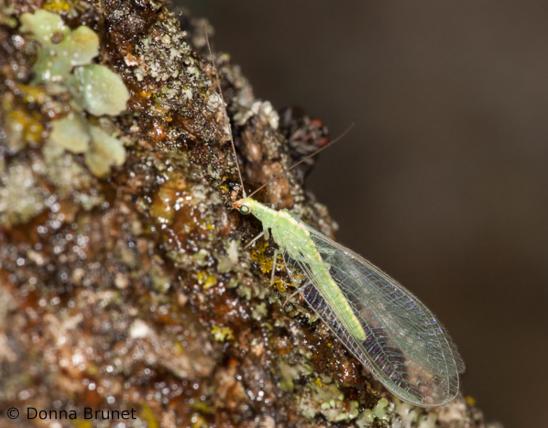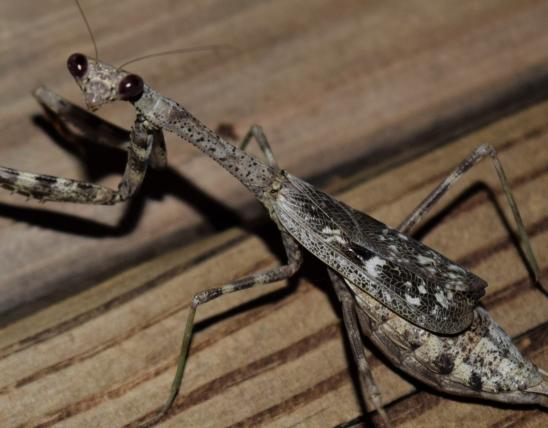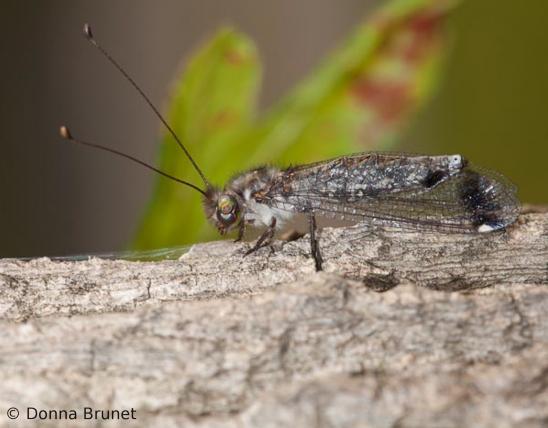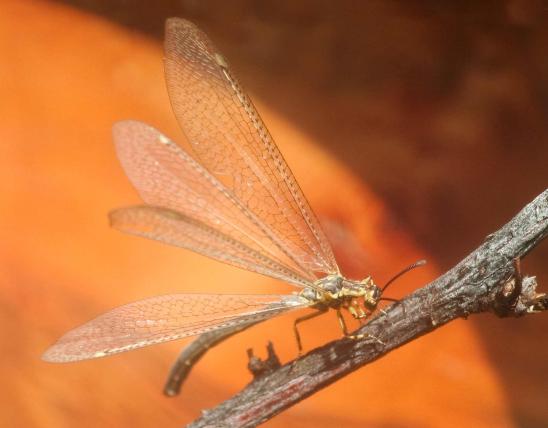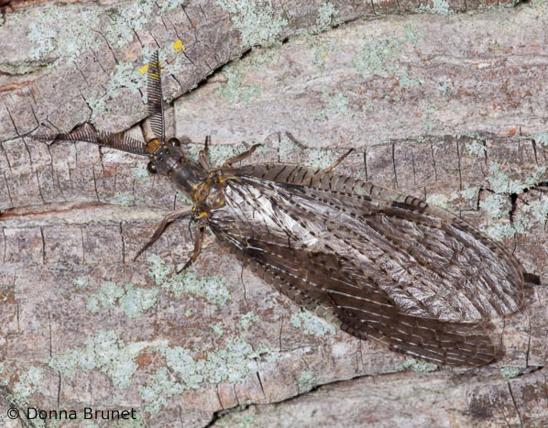Mantidflies, also called mantis flies or mantispids, look like a cross between a lacewing insect and a praying mantis. They are small, delicate creatures with intricately veined wings, but the front half looks like a small mantid, complete with raptorial forelegs.
Mantidflies are not hard to identify, if you know what lacewing insects and praying mantises look like — just imagine the two insects stuck together, and about an inch long. But to sharpen your ID skills, note some of these finer points of identification:
- The antennae are threadlike, toothed, or feathery, but they are never clubbed.
- The head is like that of a praying mantis: triangular, with big eyes on the top two corners and the mouth at the bottom corner.
- The prothorax (front portion of the thorax, which is the midpart of the body between head and abdomen), is elongated; some say it looks like the neck of a giraffe.
- The front pair of legs are like those of a praying mantis: they are modified for grabbing hold of prey, with a big claw at the tip that closes against the wide, spiny tibial segment.
- The front pair of legs are attached to the body at the front end of the prothorax, appearing just behind the head. The front legs are not used for walking; they are held up.
- The middle and hind pairs of legs are attached farther back on the body, and these are the only ones used for walking.
- The 2 forewings and 2 hindwings are all very alike and are similar to those of lacewings; both are in the “nerve-winged insects” order, with an intricate netlike pattern of veins on the wings.
Mantidflies vary in color. Most are either green or brownish, tan, grayish, or yellowish. Some common species include:
- The green mantidfly (Zeugomantispa minuta) is pale lime green, about the same color as a green lacewing. Their large eyes can be ornately patterned with a rainbow of iridescent colors. Their larvae are parasitoids in the egg sacks of spiders; adults capture and eat small insects. Missourians start seeing this species starting in late spring.
- The brown wasp mantidfly (Climaciella brunnea) is typically banded with yellow, brown, rust, or black — it looks like a horror movie combo of a wasp and praying mantis, and even the wings are colored and patterned to resemble those of wasps. The wasp mimicry no doubt helps protect them from predators. Interestingly, across its broad North American range, this mantidfly is highly variable, matching the coloration of the wasps that are abundant locally. It lives in grasslands and other open habitats, where it hunts insects that visit flowers. Larvae are parasitoids of spiders. The adults are often attracted to lights at night.
- Say’s mantidfly (Dicromantispa sayi, syn. Mantispa sayi), the four-spotted, spot-tipped, or interrupted mantidfly (D. interrupta), and a species whose name translates to “beautiful slender mantidfly” (Leptomantispa pulchella) are all rather nondescript tan, brownish, or yellowish and are widespread in the eastern United States.
Similar species: It’s easy to see the similarity with green lacewings and other lacewings (there are a number of lacewing families, including Chrysopidae), and with the various species of mantises. Mantidflies are much more closely related to lacewings than they are to true praying mantids. Here are some other insects that are similar:
- Dustywings (family Coniopterygidae) are tiny, no bigger than 3 mm (about ⅛ inch) in length. They look something like miniature lacewings covered with dust. They have long, threadlike antennae. If you’re familiar with whiteflies, they look something like those. As larvae, they’re predators of aphids, mites, scale insects, and other small creatures.
- Snakeflies (now with their own order, Raphidioptera, but formerly in the Neuroptera) are not found in Missouri, but if you travel to western states, keep an eye out for these nifty, harmless animals. They resemble mantidflies but don’t have the raptorial forelegs. Their long, necklike prothorax and long, wide head, usually held up and bobbing around like a cobra’s, makes them look really weird. The females, with their freakishly long, flexible ovipositor, look downright scary. Again, they're completely harmless, except to the insects they eat.
- Other insects that used to be in order Neuroptera that are now split into different groups are the alderflies, dobsonflies and fishflies, owlflies, and antlions.
Adult length: ¾–1¼ inches.
Statewide. Mantidflies are most common in southern parts of the United States.
Habitat and Conservation
Mantidflies are not very common. They may be found where their prey abounds, which generally means that they can occur anywhere insects and spiders live. Certain mantidfly species are more commonly associated with open, grassy areas, others with lowlands, and so on. Many species are attracted to lights at night. Blacklights, especially, may attract them. Generally, the adults appear in late April through June and may continue to be present until heavy frosts zap them in October.
Food
Adult mantidflies capture and eat their prey just as praying mantises do, snatching up a smaller insect, mite, or other arthropod, grasping it with the strong, spiny forelegs, and then chomping away.
The larval mantidflies are wormlike or grublike parasitoids that enter the egg sacs of spiders and eat the eggs within. In some cases, the larval mantidfly must grab onto a female spider and ride around on her for a while — apparently sucking her juices like a louse—before transferring from her to her egg sac. If the larval mantidfly hops onto a male spider, then it transfers to a female when the two mate, and then transfers to the eggs when they are laid.
Larval mantidflies most commonly target various types of running or hunting spiders — the kinds that run around on the ground or crawl on plants — as opposed to the web-building species. Different mantidflies may focus on particular types of spiders. For example, the brown wasp mantidfly specializes in wolf spiders.
The adult size of a mantidfly varies with the amount of food it consumed as a larva.
Life Cycle
Would it surprise you that such a bizarre little animal would also have an unusual life cycle? While many insects, such as butterflies and beetles, have a typical complete metamorphosis — progressing from an egg (resting), to a larva (active), to a pupa (resting), to an adult (active) — mantidflies complicate the pattern in a cycle called hypermetamorphosis:
- The eggs are individually stalked (similar to lacewings, but on shorter stalks), usually deposited in large clusters.
- The larval stages are quite different from each other, with the first larval stage slender, agile, and either actively searching for a spider egg sac to enter, or else (often literally) hopping onto a spider, which it rides around on until the spider creates an egg sac; the larva then sneaks into the sac while it is being constructed.
- Then, safely inside the spider egg sac, the larva molts into a chubbier, more grublike, much less active form. It spends its time simply feeding on the spider eggs.
- The full-grown larva then spins its cocoon and pupates. At first, the pupa rests within its old larval skin, but then the pupa becomes active, sheds the larval skin, and looks something like a wingless adult. This second-phase pupal form is active and crawls around on its old cocoon and the spider’s spent egg sac. Upon its next molt, it acquires its wings and is a fully mature adult.
- The adults are sexually mature males and females that mate, lay eggs, and continue the cycle.
- Note that in some groups of mantidflies, the larvae are more straightforward predators of the larvae of other insects.
Human Connections
Mantidflies — seeming mashups between mantises and lacewings — appear to have a lot in common with centaurs (human-horses), hippocampuses (horse-fishes), the Minotaur (a bull-human), and fauns (human-goats). But those are mythical creatures, and mantidflies are real inhabitants of planet Earth. Aren’t we lucky to live on such an amazing world?
The insect world is full of fascination, beauty, and sometimes horror. No wonder they serve as inspiration for fantastic movies, novels, and mythical tales. Science and common sense, however, ask us to hold our feelings and preconceptions in check before we pass knee-jerk judgment on the natural world.
Most people would consider mantidflies “friendly,” since they serve as a control on spiders, insects, and other small arthropods. But mantidflies alone are probably not abundant enough to have a great effect on other small creatures.
Ecosystem Connections
Alone, mantidflies are probably not common or abundant enough to have a large effect on the populations of the small invertebrates they prey on — but combined with spiders, assassin bugs, robber flies, ants, lady beetles, mantises, and other predatory arthropods, they serve an important function in natural ecosystems.
Adult mantidflies — delicate and small, despite their predatory nature — can be eaten by a wide variety of animals ranging from spiders, assassin bugs, and so on to birds, lizards, frogs, fish, shrews, salamanders, and more. Mantidflies can be several links in a long, complicated food web. Here are a few scenarios:
- Mantidflies are not strong fliers, and bats or nighthawks may easily capture them at night.
- If a mantidfly falls onto the surface of a lake, a fish or water strider might eat it.
- An agile, lizard-like first-stage larval mantidfly, walking on a fallen log and looking for a spider to hop onto, may instead be grabbed and sucked dry by a red velvet mite.
- A pudgy larval mantidfly — holed up in a spider’s egg case (we imagine it burping after its nice meal) — may, in a flash, be swallowed by a chickadee, which was expecting a meal of spider eggs.






















